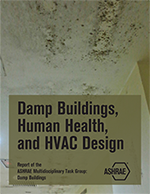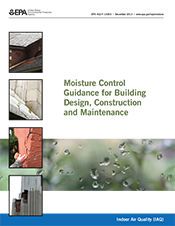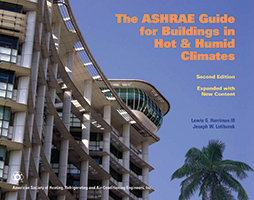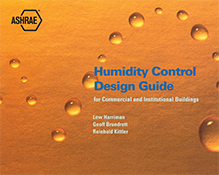Humidity Resources from ASHRAE

Effective humidity control is essential to maintaining built environments for both the health of the building and its occupants, and ensuring optimum performance of building systems.
Damp Buildings, Human Health, and HVAC Design

This report summarizes dampness-related health risks in buildings as understood within ASHRAE. It provides simple-to-recognize symptoms of dampness, describes its capacity to increase the probability of negative health effects, and provides suggestions that HVAC system designers can apply to minimize such risks. The text also suggests monitoring instruments and threshold values that can provide early warning of trends that, if allowed to continue, could eventually result in health-relevant dampness.
ASHRAE Position Document on Limiting Indoor Mold and Dampness in Buildings
This position document provides help in understanding some of the complex interactions and decisions that lead to indoor dampness. A building’s mechanical systems, its exterior enclosure, and its occupant activities all affect the amount of wetting and drying indoors. Therefore, ASHRAE takes the position that all policymakers, regulatory authorities, building professionals, and building occupants should be aware that indoor dampness, mold, and microbial growth are warnings of potential problems. All concerned should make decisions and take actions that help buildings, their contents, and their systems stay as dry as possible, given their functions. However, professionals and the public need to know, with greater certainty than at present, when a building is “dry enough” to avoid dampness-related health risks.
Download
"Moisture and Mold," Chapter 64 of the 2019 ASHRAE Handbook--Applications
Indoors, buildings should always be dry. When building interiors get damp and stay damp, problems often emerge for their occupants and for the building's structure, material, and furnishings. Persistent indoor dampness has been associated with human health problems, increased risk to buildings' structural fasteners and exterior enclosure, shortened useful life of furnishings, and reduced acceptability to occupants because of odors and stains. These and related problems can be costly and disruptive, as well as annoying to all concerned.
Purchase I-P Purchase SI
"Moisture Management in Buildings," Chapter 36 of the 2017 ASHRAE Handbook--Fundamentals
This chapter presents data on indoor vapor release and measured indoor/outdoor vapor pressure or vapor concentration differences not included elsewhere in the ASHRAE Handbook and discusses moisture sources and sinks that can reduce materials' durability, as well as the negative effects of insufficient or excessive indoor relative humidity.
PURCHASE I-P PURCHASE SI
Moisture Control Guidance for Building Design, Construction and Maintenance

This work was developed by the U.S. Environmental Protection Agency, Indoor Environments Division and provides practical guidance on how to control moisture in buildings. Chapter 1 focuses on principles of moisture control: how water moves into and within a building and why the movement of water should be controlled or managed. Chapters 2, 3 and 4 provide profession-specific guidance for the design, construction and maintenance phases of a building's life. Each guidance chapter contains hyperlinks to relevant principles described in Chapter 1 and other related material throughout the text. Each guidance chapter also includes methods for verifying the appropriate implementation of the moisture control recommendations and a reference section that identifies additional related resources for readers interested in more detailed information.
English Spanish
ASHRAE Guide for Buildings in Hot and Humid Climates, 2nd Ed.

This guide provides information on building enclosures, dehumidification, sustainability, mold avoidance, energy reduction, and much more - all tightly focused on the needs of owners, architects, and engineers who build and manage buildings in hot and humid climates. The book includes six chapters that discuss critical crosscutting issues for architecture, engineering, and building management along with eleven chapters of detailed and practical solutions to everyday problems in each area. This expanded second edition provides a richly illustrated summary of the state of the art in building science, moisture management, and techniques for reducing energy consumption in hot and humid climates, all based on real-world field experience as well as on recent ASHRAE research.
Purchase
Humidity Control Design Guide for Commercial and Institutional Buildings

This book helps technical professionals design humidity control systems for commercial buildings. The over 500-page guide provides HVAC designers with complete coverage of humidity control from basic principles to real-world design advice and is organized in a logical, easy-to-follow layout. It provides a solid background in humidity control, including a review of its causes and effects; discusses the roles of various people involved in the design and operation of a building, including owners, HVAC designers, and contractors, in controlling humidity; covers 15 different types of equipment related to humidity control design; spotlights 13 different types of buildings, including schools, office buildings, retail buildings, and hotels; includes 25 pages of weather data; and has a reference section that features dehumidification equations, conversion tables and factors, and a pyschrometric chart.
ENGLISH CHINESE
Mold and Moisture Management in Buildings
This 2004 collection of more than 20 articles and papers from ASHRAE Journal, ASHRAE IAQ Conferences, and ASHRAE's semi-annual meetings offers guidance to help avoid mold and moisture problems in buildings. It shows how moisture behaves in buildings, what happens when there is too much of it, and how these problems can be avoided. It provides extensive technical background along with specific suggestions. The papers are organized into five sections: Mold Fundamentals; Moisture Behavior in Buildings; Dehumidification & HVAC Systems; Commercial Buildings, Problems and Solutions; and Residential Buildings, Problems and Solutions. This collection is ideal for designers, engineers, building owners and managers, architects, facility/plant management, O&M personnel, and quality control managers.
PURCHASE
Related Courses
Avoiding IAQ Problems
Humidity Control I: Design Tips and Traps
Humidity Control II: Real-World Problems and Solutions
Humidity Control I and II: Tips for HVAC Design and Practical Solutions to Existing Problems – 6 hours
Integrated Building Design – 6 hours